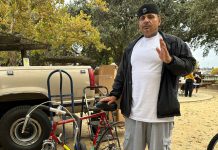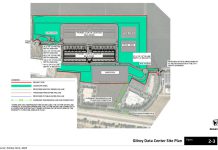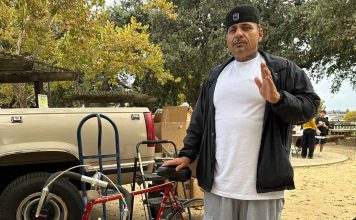Imagine bicycling from Gilroy to Napa, then circling the Bay and
returning to Gilroy.
Imagine bicycling from Gilroy to Napa, then circling the Bay and returning to Gilroy.
That is the dream of National Park Service Director William Penn Mott Jr., who 20 years ago envisioned a trail that would ring the entire San Francisco Bay, offering vistas of soaring beauty high on the ridge line and traveling through many parks and beautiful natural spaces. Although he only lived to see part of the trail completed, he inspired a dedicated grassroots effort that has made amazing progress.
Mott’s vision of the Bay Area Ridge Trail is becoming a reality thanks to the effective collaboration of volunteer activists, nonprofit organizations and public agencies at all levels. Today, with more than 300 miles of the trail dedicated, there are completed sections of the trail in all nine counties around the Bay, and no one in the area lives more than one-half hour away from a completed section of the trail. It will ultimately be a 500-plus mile continuous multi-use trail along the ridgeline for mountain bicyclists, walkers, hikers/trail runners, equestrians and outdoor enthusiasts of all types.
The trail will eventually encircle the entire San Francisco Bay Area, from Yountville in Napa Valley in the north, all the way to Gilroy at its southernmost tip. Gilroy is currently in the process of building its first links to this regional trail.
For a map fo the trail and its proposed extensions, see the bottom of this story.
In July 2006, the California River Parkways Program granted the city of Gilroy $520,000 for a nearly one-mile trail extension along the current popular Uvas Creek path, which will extend the scenic pathway further south from Santa Teresa Boulevard to the ranch site facing Christmas Hill Park.
The state agency also granted the city $492,000 to create a quarter-mile trail connecting Antonio Del Buono Elementary School to Lion’s Creek in north Gilroy, which will run south along Church Street before heading west toward Wren Avenue. The Lion’s Creek trail segment is the first northern link of the citywide trail system that will one day connect Gilroy to The Bay Area Ridge Trail.
Building even the relatively short quarter-mile trail connecting Antonio Del Buono Elementary School to Lion’s Creek is a process that requires many steps.
“To plan these trails, you take into account 50 different opinions,” explained Bill Headley, city facilities and parks development manager. “Homeowners’ groups, developers, school boards, the water district, the Valley (Transportation) Authority, the county parks department, and special interest groups such as cross country and equestrian users – then you work out a compromise that meets what the community has determined to be the greatest need.”
Once consensus was reached and city council approved the Trails Master Plan, seeking funding streams for the top two priority trails began.
“The city identified the Uvas and Lion’s Creek segments as top priorities because they offered a safer route to schools,” said Lee Steinmetz, the landscape architect whose team designed both trails and helped procure grant funding. “They run along waterways, which is a requirement for the state grant money the city was seeking.”
“We can liaise and leverage our local funds to the best of our ability, working with local partners and building developers,” Headley said. “The city’s Master Plan is a supporting document to the General Plan, and it enables us to require other agencies to work with our community to address issues as we envision them. Our city is progressive; you won’t find many communities that have master plans for the infrastructure that we have. We want to be able to bike or walk to any part of town in the future.”
One way the city’s funds are being stretched is by finding the most viable ways to connect with other existing trails or roads.
“For example,” Steinmetz said, “Using the water district maintenance road as part of the Lion’s Creek Trail saves the city money, since we only need land use permits for that part of the trail, rather than having to buy the land.” Meeting the requirements for building these trail segments ensures that the habitat around these drainage channels and watershed areas will be protected and preserved.
“The challenges of planning a Gilroy trail segment can be compared to taking on the trickiest jigsaw puzzle you’ve ever tried,” said Allen Douglas, a member of the Pedestrian and Bicycle Advisory Board. “The plan must include determining how that path will facilitate trip reduction schedules, create safer routes to schools, and link to public transportation and bikeways, as well as to other regional, county and state parks and trails.”
Steinmetz said final construction details are be worked out and plans will go out to bid soon.
The trails will be 12-feet wide and paved, and can be used by everyone from cyclists to walkers, with the exception of horses, he said. Some areas will be fenced, and there will be nice benches to sit on and take in the scenic views.
“We expect construction of both trails to be completed by next spring,” he said.
Mayor Al Pinheiro is pleased with the progress.
“Gilroy is known for its parks, and one of our top priorities is to be able to provide ways to connect our people in a positive way,” he said. “Anytime we can find money to give our citizens a better quality of life, that’s a priority.”
Hairdresser Ellen Beale, a frequent hiker along the current Uvas Creek Trail, is enthusiastic about the idea of the trail being extended and hopes one day to be able to easily travel around any part of Gilroy by foot.
“I’m ready to leave my car at home and I do as often as possible,” Cyclist John Warner said. “It’s thrilling to take my family out to enjoy such pretty surroundings; I look forward to being able to go all the way from Gilroy to Morgan Hill and on to San Jose by bike.”
“We enjoy one of the most ideal climate and life zones in the country, but this is about more than creating nice recreation areas,” Headley said. “This is about the ways people connect with each other in our city and making sure those future opportunities are not lost through poor planning now. For the sake of our community, we have to set goals and plan this stuff out as far as we can into the future.”
Cambri Love, freshman student at West Valley College, is enrolled in a class which takes students to various trails all over the bay area for walking exercise. Headley sees this as the way of the future.
“Trails can be used to educate our kids,” Headley said. “How do we get kids back into walking again the way we did when we were growing up? Being the best stewards we can be in ensuring how the natural and the manmade environments co-exist and work together determines what kind of future our children will have. We are going to have to get out of our vehicles more, for our own health, the health of our families, and the health of the planet. We may never see the culmination of this trail system ourselves, but our grandchildren will finish it one day.”
For more info, go to















